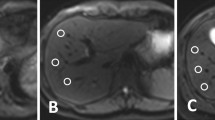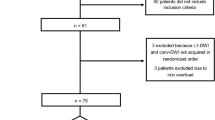Abstract
Purpose: To perform image quality comparison between accelerated multiband diffusion acquisition (mb2-DWI) and conventional diffusion acquisition (c-DWI) in patients undergoing clinically indicated liver MRI. Methods: In this prospective study 22 consecutive patients undergoing clinically indicated liver MRI on a 3-T scanner equipped to perform multiband diffusion-weighed imaging (mb-DWI) were included. DWI was performed with single-shot spin-echo echo-planar technique with fat-suppression in free breathing with matching parameters when possible using c-DWI, mb-DWI, and multiband DWI with a twofold acceleration (mb2-DWI). These diffusion sequences were compared with respect to various parameters of image quality, lesion detectability, and liver ADC measurements. Results: Accelerated mb2-DWI was 40.9% faster than c-DWI (88 vs. 149 s). Various image quality parameter scores were similar or higher on mb2-DWI when compared to c-DWI. The overall image quality score (averaged over the three readers) was significantly higher for mb-2 compared to c-DWI for b = 0 s/mm2 (3.48 ± 0.52 vs. 3.21 ± 0.54; p = 0.001) and for b = 800 s/mm2 (3.24 ± 0.76 vs. 3.06 ± 0.86; p = 0.010). Total of 25 hepatic lesions were visible on mb2-DWI and c-DWI, with identical lesion detectability. There was no significant difference in liver ADC between mb2-DWI and c-DWI (p = 0.12). Bland–Altman plot demonstrates lower mean liver ADC with mb2-DWI compared to c-DWI (by 0.043 × 10−3 mm2/s or 3.7% of the average ADC). Conclusion: Multiband technique can be used to increase acquisition speed nearly twofold for free-breathing DWI of the liver with similar or improved overall image quality and similar lesion detectability compared to conventional DWI.




Similar content being viewed by others
References
Bharwani N, Koh DM (2013) Diffusion-weighted imaging of the liver: an update. Cancer Imaging 13:171–185
d’Assignies G, Fina P, Bruno O, et al. (2013) High sensitivity of diffusion-weighted MR imaging for the detection of liver metastases from neuroendocrine tumors: comparison with T2-weighted and dynamic gadolinium-enhanced MR imaging. Radiology 268(2):390–399
Taouli B, Ehman RL, Reeder SB (2009) Advanced MRI methods for assessment of chronic liver disease. Am J Roentgenol 193(1):14–27
Namimoto T, Yamashita Y, Sumi S, Tang Y, Takahashi M (1997) Focal liver masses: characterization with diffusion-weighted echo-planar MR imaging. Radiology 204(3):739–744
Kim T, Murakami T, Takahashi S, et al. (1999) Diffusion-weighted single-shot echoplanar MR imaging for liver disease. Am J Roentgenol 173(2):393–398
Cui Y, Zhang XP, Sun YS, Tang L, Shen L (2008) Apparent diffusion coefficient: potential imaging biomarker for prediction and early detection of response to chemotherapy in hepatic metastases. Radiology 248(3):894–900
Parikh T, Drew SJ, Lee VS, et al. (2008) Focal liver lesion detection and characterization with diffusion-weighted MR imaging: comparison with standard breath-hold T2-weighted imaging. Radiology 246(3):812–822
Taouli B, Koh DM (2010) Diffusion-weighted MR Imaging of the Liver. Radiology 254(1):47–66
Taouli B, Sandberg A, Stemmer A, et al. (2009) Diffusion-weighted imaging of the liver: comparison of navigator triggered and breathhold acquisitions. J Magn Reson Imaging 30(3):561–568
Bruegel M, Holzapfel K, Gaa J, et al. (2008) Characterization of focal liver lesions by ADC measurements using a respiratory triggered diffusion-weighted single-shot echo-planar MR imaging technique. Eur Radiol 18(3):477–485
Asbach P, Hein PA, Stemmer A, et al. (2008) Free-breathing echo-planar imaging based diffusion-weighted magnetic resonance imaging of the liver with prospective acquisition correction. J Comput Assist Tomo 32(3):372–378
Choi JS, Kim MJ, Chung YE, et al. (2013) Comparison of breathhold, navigator-triggered, and free-breathing diffusion-weighted MRI for focal hepatic lesions. J Magn Reson Imaging 38(1):109–118
Chen X, Qin L, Pan D, et al. (2014) Liver diffusion-weighted MR imaging: reproducibility comparison of ADC measurements obtained with multiple breath-hold, free-breathing, respiratory-triggered, and navigator-triggered techniques. Radiology 271(1):113–125
Kwee TC, Takahara T, Koh DM, Nievelstein RAJ, Luijten PR (2008) Comparison and reproducibility of ADC measurements in breathhold, respiratory triggered, and free-breathing diffusion-weighted mr imaging of the liver. J Magn Reson Imaging 28(5):1141–1148
Nasu K, Kuroki Y, Fujii H, Minami M (2007) Hepatic pseudo-anisotropy: a specific artifact in hepatic diffusion-weighted images obtained with respiratory triggering. Magn Reson Mater Phys 20(4):205–211
Feinberg DA, Setsompop K (2013) Ultra-fast MRI of the human brain with simultaneous multi-slice imaging. J Magn Reson 229:90–100
Lau AZ, Tunnicliffe EM, Frost R, Koopmans PJ, Tyler DJ, Robson MD (2015) Accelerated human cardiac diffusion tensor imaging using simultaneous multislice imaging. Magn Reson Med 73(3):995–1004
Setsompop K, Gagoski BA, Polimeni JR, et al. (2012) Blipped-controlled aliasing in parallel imaging for simultaneous multislice echo planar imaging with reduced g-factor penalty. Magnet Reson Med 67(5):1210–1224
Landis JR, Koch GG (1977) The measurement of observer agreement for categorical data. Biometrics 33(1):159–174
Griswold MA, Jakob PM, Heidemann RM, et al. (2002) Generalized autocalibrating partially parallel acquisitions (GRAPPA). Magn Reson Med 47(6):1202–1210
Pruessmann KP, Weiger M, Scheidegger MB, Boesiger P (1999) SENSE: sensitivity encoding for fast MRI. Magn Reson Med 42(5):952–962
Sodickson DK, Manning WJ (1997) Simultaneous acquisition of spatial harmonics (SMASH): Fast imaging with radiofrequency coil arrays. Magn Reson Med 38(4):591–603
Acknowledgment
Kawin Setsompop, Ph.D. Stephen F. Cauley, Ph.D. Athinoula A. Martinos Center for Biomedical Imaging, Department of Radiology, Massachusetts General Hospital, Charlestown, Massachusetts, USA.
Author information
Authors and Affiliations
Corresponding author
Rights and permissions
About this article
Cite this article
Obele, C.C., Glielmi, C., Ream, J. et al. Simultaneous Multislice Accelerated Free-Breathing Diffusion-Weighted Imaging of the Liver at 3T. Abdom Imaging 40, 2323–2330 (2015). https://doi.org/10.1007/s00261-015-0447-3
Published:
Issue Date:
DOI: https://doi.org/10.1007/s00261-015-0447-3




